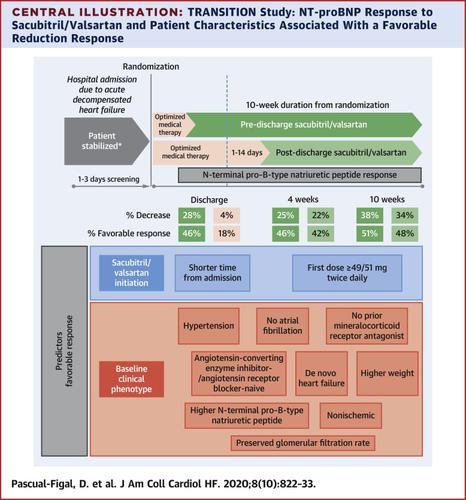JACC: Heart Failure ( IF 13.0 ) Pub Date : 2020-08-12 , DOI: 10.1016/j.jchf.2020.05.012 Domingo Pascual-Figal 1 , Rolf Wachter 2 , Michele Senni 3 , Weibin Bao 4 , Adele Noè 5 , Heike Schwende 6 , Dmytro Butylin 6 , Margaret F Prescott 4 ,

|
Objectives
This study examined the effects of sacubitril/valsartan on N-terminal pro–B-type natriuretic peptide (NT-proBNP) levels and determined patient characteristics associated with favorable NT-proBNP reduction response.
Background
NT-proBNP levels reflect cardiac wall stress and predict event risk in patients with acute decompensated heart failure (ADHF).
Methods
Post-hoc analysis of the TRANSITION (Comparison of Pre- and Post-discharge Initiation of Sacubitril/Valsartan Therapy in HFrEF Patients After an Acute Decompensation Event) study, including stabilized ADHF patients with reduced ejection fraction, randomized to open-label sacubitril/valsartan initiation in-hospital (pre-discharge) versus post-discharge. NT-proBNP was measured at randomization (baseline), discharge, and 4 and 10 weeks post-randomization. A favorable NT-proBNP response was defined as reduction to ≤1,000 pg/ml or >30% from baseline.
Results
In patients receiving sacubitril/valsartan in-hospital, NT-proBNP was reduced by 28% at discharge, with 46% of patients obtaining favorable NT-proBNP reduction response compared with a 4% reduction and 18% favorable response rate in patients initiated post-discharge (p < 0.001). NT-proBNP was reduced similarly in patients initiating sacubitril/valsartan pre- and post-discharge (reduction at 4 weeks: 25%/22%; 10 weeks: 38%/34%) with comparable favorable response rates (46%/42% and 51%/48% at 4 and 10 weeks, respectively). NT-proBNP favorable response at 4 weeks was associated with lower risk of first heart failure (HF) rehospitalization or cardiovascular death through 26 weeks (hazard ratio: 0.57; 95% confidence interval [CI]: 0.38 to 0.86; p = 0.007). Predictors of a favorable response at 4 weeks were starting dose ≥49/51 mg twice daily, higher baseline NT-proBNP, lower baseline serum creatinine, de novo HF, no atrial fibrillation, angiotensin-converting enzyme inhibitor–naive or angiotensin receptor blocker–naive, and no prior myocardial infarction.
Conclusions
In-hospital initiation of sacubitril/valsartan produced rapid reductions in NT-proBNP, statistically significant at discharge. A favorable NT-proBNP response over time was associated with a better prognosis and predicted by higher starting dose and predisposing clinical profile. (Comparison of Pre- and Post-discharge Initiation of LCZ696 Therapy in HFrEF Patients After an Acute Decompensation Event [TRANSITION]; NCT02661217)
中文翻译:

NT-proBNP 在射血分数降低的住院心力衰竭患者中对沙库巴曲/缬沙坦的反应:TRANSITION 研究。
目标
本研究检查了沙库巴曲/缬沙坦对 N 端 B 型利钠肽原 (NT-proBNP) 水平的影响,并确定了与有利的 NT-proBNP 降低反应相关的患者特征。
背景
NT-proBNP 水平反映心壁应力并预测急性失代偿性心力衰竭 (ADHF) 患者的事件风险。
方法
TRANSITION(急性失代偿事件后 HFrEF 患者出院前和出院后开始沙库巴曲/缬沙坦治疗的比较)研究的事后分析,包括射血分数降低的稳定 ADHF 患者,随机分配至开放标签沙库巴曲/缬沙坦院内(出院前)与出院后开始。NT-proBNP 在随机化(基线)、出院以及随机化后 4 周和 10 周时测量。有利的 NT-proBNP 反应定义为从基线降低至 ≤ 1,000 pg/ml 或 >30%。
结果
在住院期间接受沙库巴曲/缬沙坦治疗的患者中,出院时 NT-proBNP 降低了 28%,46% 的患者获得了有利的 NT-proBNP 降低反应,而在治疗后开始治疗的患者中,NT-proBNP 降低反应降低了 4%,反应率为 18%。放电(p < 0.001)。在出院前和出院后开始使用沙库巴曲/缬沙坦的患者中,NT-proBNP 的降低类似(第 4 周降低:25%/22%;10 周:38%/34%),具有可比的良好反应率(46%/42%) 4 周和 10 周分别为 51%/48%)。4 周时 NT-proBNP 的良好反应与 26 周内首次心力衰竭 (HF) 再住院或心血管死亡风险降低相关(风险比:0.57;95% 置信区间 [CI]:0.38 至 0.86;p = 0.007)。4 周时反应良好的预测因素是起始剂量≥49/51 mg 每天两次,
结论
院内开始使用沙库巴曲/缬沙坦可使 NT-proBNP 迅速降低,在出院时具有统计学意义。随着时间的推移,有利的 NT-proBNP 反应与更好的预后相关,并通过更高的起始剂量和易感的临床特征进行预测。(急性失代偿事件后 HFrEF 患者出院前和出院后启动 LCZ696 治疗的比较 [TRANSITION];NCT02661217)


























 京公网安备 11010802027423号
京公网安备 11010802027423号